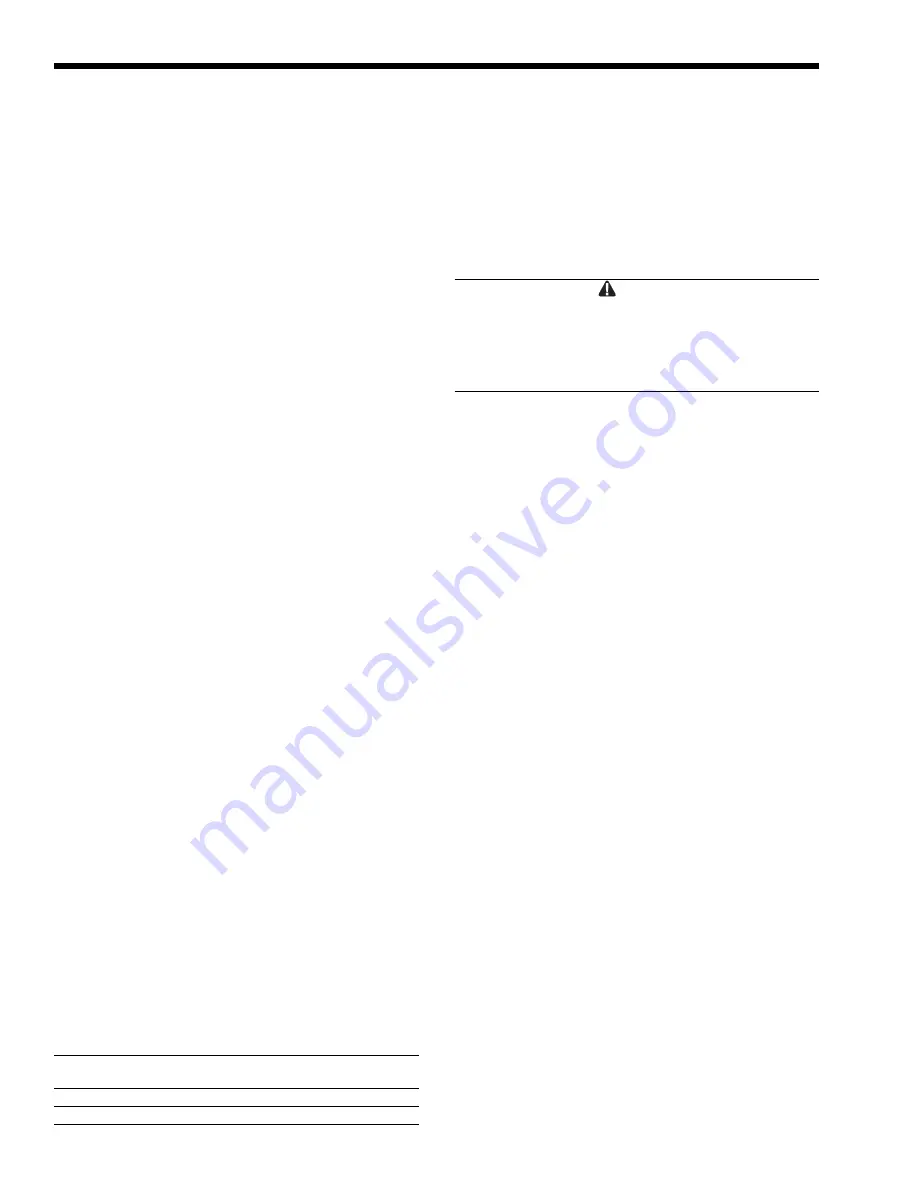
LAARS Heating Systems
Page 18
HEATER
MINIMUM FILTER
MODEL
PUMP FLOW RATE
PNCP 500
240 GPM
PNCP 750
360 GPM
Table 9. Minimum Filter Pump Flow Rates For Spas.
again and the burner will start. The
appliance will return to its previous mode
of operation.
NOTE:
Models 1250, 1500, 1750 and 2000 have two
ignition controls and two ignitors.
6.3.2 High Altitude Adjustment and Set Up
Pennant appliances may be operated at high altitude
(7700 ft., 2347 m) with a reduction in output of
approximately 10%. At elevations higher than 7700 ft.
(2347 m) the reduction in output will exceed 10% and at
elevations below 7700 ft. (2347 m) it will be less than
10%. When adjusted properly, the appliance will perform
properly at any altitude. High altitude adjustment must
not be made on appliances operating at elevations below
2500 ft. (762 m).
No orifice changes are required to adjust the
Pennant appliances for high altitude. High altitude
adjustment is accomplished by adjustment of the gas
valve manifold pressure and the air shutter(s). The
required instruments used to assist in these
adjustments are a CO
2
or O
2
Analyzer and a U-Tube
Manometer or other device capable of reading a
pressure of 2.5-3.0 inches W.C. (0.62-0.75 kPa).
Start the adjustment process by checking the CO
2
in the “as installed” condition. Adjust the air shutter(s)
so that the CO
2
is about 8% or the O
2
is about 6.8% for
appliances operating on Natural Gas. For appliances
operating on LP Gas adjust the air shutter(s) so that
the CO
2
is about 9.2% or the O
2
is about 6.8%.
Appliances with two blowers should be adjusted so
that the air shutters below each blower are open the
same amount.
Once the CO
2
or O
2
has been set, the manifold
pressure may be adjusted. Remove the 1/8 NPT plug
from the lower side of the gas valve that is to be set
and install a fitting, hose and manometer. Start the
appliance and observe the manifold pressure. Manifold
pressure must be adjusted to 3.0 in. W.C. (0.75 kPa)
(for high altitude only, standard operating pressure is
2.5 in. W.C. (0.62 kPa)). It is adjusted by removing the
slotted cap on the gas valve and turning the adjustment
screw (beneath the cap) clockwise to increase pressure
. After the adjustments have been completed, the
fitting, hose and manometer have been removed and
the 1/8" plug has been replaced, replace the cap.
Repeat this process until all gas valves have been set.
Note: The pressure can be set only when the appliance
is operating and only when the particular gas valve
being adjusted is energized by a call for heat.
After all of the gas valve manifold pressures
have been set, the CO
2
or O
2
must be reset. CO
2
or O
2
will have changed when the manifold pressure was
adjusted. Open the air shutter(s) to reduce the CO
2
or
O
2
to the values achieved previously.
The procedure is complete when all gas valves
are adjusted to a manifold pressure of 3.0 in. W.C.
(0.75 kPa) and the CO
2
is adjusted to 8.0% for Natural
Gas appliances or 9.2% for LP appliances. When
using an O
2
analyzer, the correct O
2
is 6.8% for both
Natural Gas and LP appliances.
Caution
Should any odor of gas be detected, or if the gas
burner does not appear to be functioning in a
normal manner, close main shutoff valve, do not
shut off switch, and contact your heating contractor,
gas company, or factory representative.
6.4 Shutting Down the Pennant
1.
Switch off the shutdown switch (located above
the Main Power Switch).
2.
Wait until the “pump” light (located on the front
panel) goes out.
3.
Switch off the main electrical disconnect switch.
4.
Close all manual gas valves.
5.
If freezing is anticipated, drain the Pennant and
be sure to also protect piping connected to the
Pennant from freezing.
This step to be performed by a qualified service person.
6.5 Backwash Switch Operation
Pennant Pool Heaters are equipped with a filter
backwash switch, which is located above the main
power switch. The switch is intended to provide a
means by which the heater can be safely shut down for
pool filter service, without causing nuisance tripping
of the heater high limit.
This switch is internally wired in series with the
Other Interlocks terminals, and will interrupt the call
for heat signal when open. Please note that when the
backwash switch is active the heater “Service” light
will be illuminated.
To place the heater into backwash mode proceed
as follows:
1.
Turn the backwash switch down to the “Filter
Backwash Mode” position.
2.
Wait for the heater outlet temperature to drop
down to a temperature equal to the pool water
return temperature.
3.
Turn the main power switch off.
Pool filter servicing may now proceed normally.
After completion of the filter servicing, place the
heater back into service as follows:
1.
Turn the main power switch on.
2.
Allow time for the pump to turn on, and purge
air from the heater.
3.
Turn the backwash switch up to the “Normal”
position.
Summary of Contents for PNCP
Page 30: ...LAARS Heating Systems Page 30 Figure 10 Sheet Metal Components...
Page 31: ...Pennant Pool Heater Page 31 Figure 11 Internal Components...
Page 34: ...LAARS Heating Systems Page 34 Figure 14 Pennant 1250 2000 Ladder Diagram...
Page 35: ...Pennant Pool Heater Page 35 Figure 15 Pennant 500 1000 Wiring Schematic...
Page 36: ...LAARS Heating Systems Page 36 Figure 16 Pennant 1250 1500 Wiring Schematic...
Page 37: ...Pennant Pool Heater Page 37 Figure 17 Pennant 1750 2000 Wiring Schematic...
Page 38: ...LAARS Heating Systems Page 38 Figure 18 Field Wiring...
Page 39: ...Pennant Pool Heater Page 39...
















































